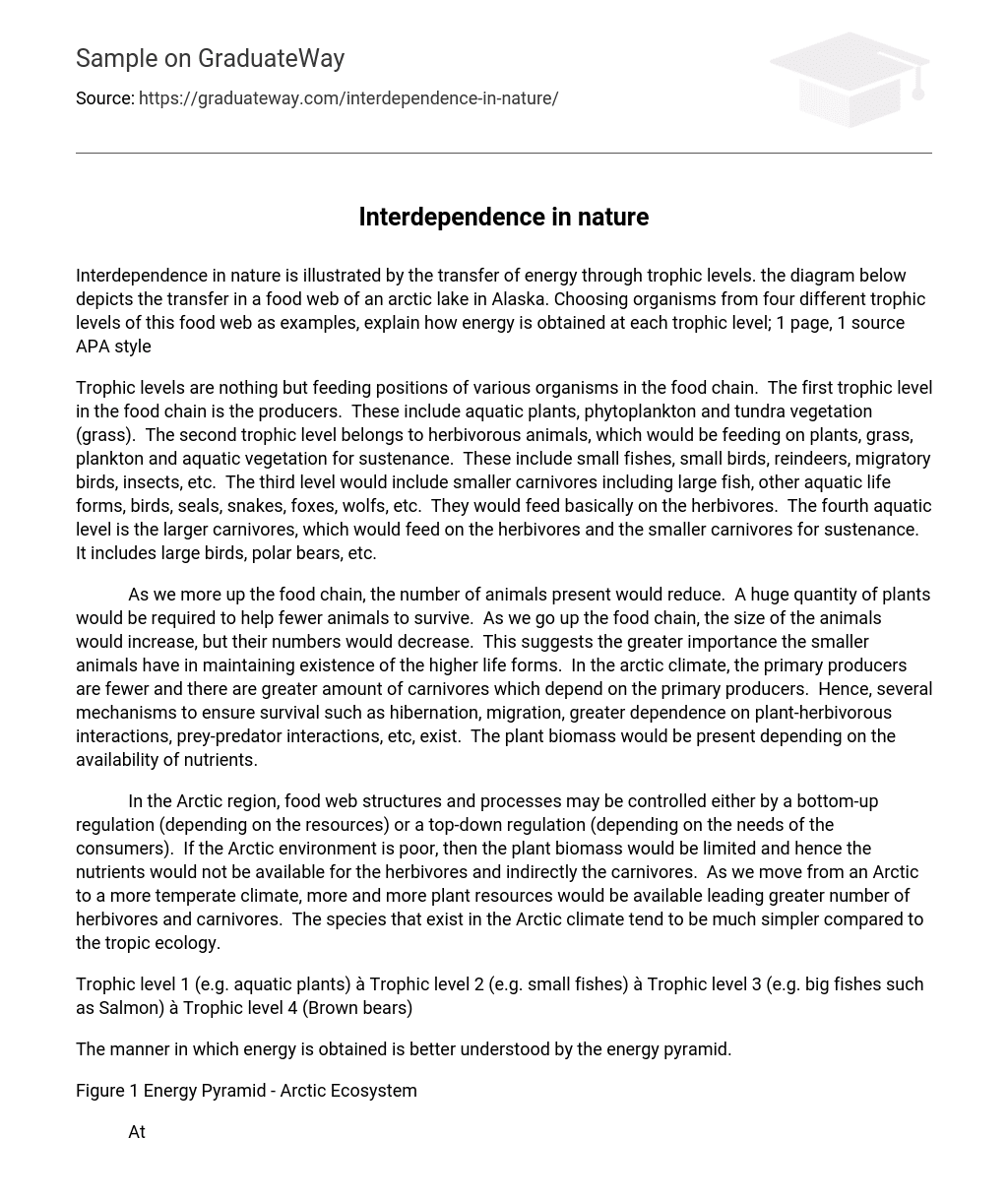Interdependence in nature is illustrated by the transfer of energy through trophic levels. the diagram below depicts the transfer in a food web of an arctic lake in Alaska. Choosing organisms from four different trophic levels of this food web as examples, explain how energy is obtained at each trophic level; 1 page, 1 source APA style
Trophic levels are nothing but feeding positions of various organisms in the food chain. The first trophic level in the food chain is the producers. These include aquatic plants, phytoplankton and tundra vegetation (grass). The second trophic level belongs to herbivorous animals, which would be feeding on plants, grass, plankton and aquatic vegetation for sustenance. These include small fishes, small birds, reindeers, migratory birds, insects, etc. The third level would include smaller carnivores including large fish, other aquatic life forms, birds, seals, snakes, foxes, wolfs, etc. They would feed basically on the herbivores. The fourth aquatic level is the larger carnivores, which would feed on the herbivores and the smaller carnivores for sustenance. It includes large birds, polar bears, etc.
As we more up the food chain, the number of animals present would reduce. A huge quantity of plants would be required to help fewer animals to survive. As we go up the food chain, the size of the animals would increase, but their numbers would decrease. This suggests the greater importance the smaller animals have in maintaining existence of the higher life forms. In the arctic climate, the primary producers are fewer and there are greater amount of carnivores which depend on the primary producers. Hence, several mechanisms to ensure survival such as hibernation, migration, greater dependence on plant-herbivorous interactions, prey-predator interactions, etc, exist. The plant biomass would be present depending on the availability of nutrients.
In the Arctic region, food web structures and processes may be controlled either by a bottom-up regulation (depending on the resources) or a top-down regulation (depending on the needs of the consumers). If the Arctic environment is poor, then the plant biomass would be limited and hence the nutrients would not be available for the herbivores and indirectly the carnivores. As we move from an Arctic to a more temperate climate, more and more plant resources would be available leading greater number of herbivores and carnivores. The species that exist in the Arctic climate tend to be much simpler compared to the tropic ecology.
Trophic level 1 (e.g. aquatic plants) à Trophic level 2 (e.g. small fishes) à Trophic level 3 (e.g. big fishes such as Salmon) à Trophic level 4 (Brown bears)
The manner in which energy is obtained is better understood by the energy pyramid.
Figure 1 Energy Pyramid – Arctic Ecosystem
At each trophic level energy would be stored. Plants would contain energy stored in their body, which would be consumed by the small fishes. These fishes would in turn use this energy to meet their metabolic needs and store a part of it. The larger fishes would consume these smaller fishes as use energy for building reserves and meeting metabolic needs. The final consumers would then consume the Salmon fish and use their energy for storage and metabolic activity. As we move higher from the trophic levels, the sum total of the energy stored at each level would decrease. This is due to the potential wastage in nature and problems faced during conversion of potential energy into Kinetic or heat energy. In the Arctic ecosystem, the energy wastage is less due to close interactions between various trophic levels, in order to prevent wastage when energy is transferred from one trophic level to another. Besides, energy is more often stored to tide over the unfavorable conditions. In order to reduce energy consumptions, animals may develop several mechanisms in order to slow down metabolic activity during unfavorable conditions.
References:
Find Articles (2004). Trophic Interactions in a High Arctic Snow Goose Colony1, Retrieved on August 21, 2008, from Find Articles Web site: http://findarticles.com/p/articles/mi_qa4054/is_200404/ai_n9356225
UWC (2008). Trophic levels, Retrieved on August 21, 2008, from UWC Web site: http://www.botany.uwc.ac.za/sci_Ed/grade10/ecology/trophics/troph.htm





